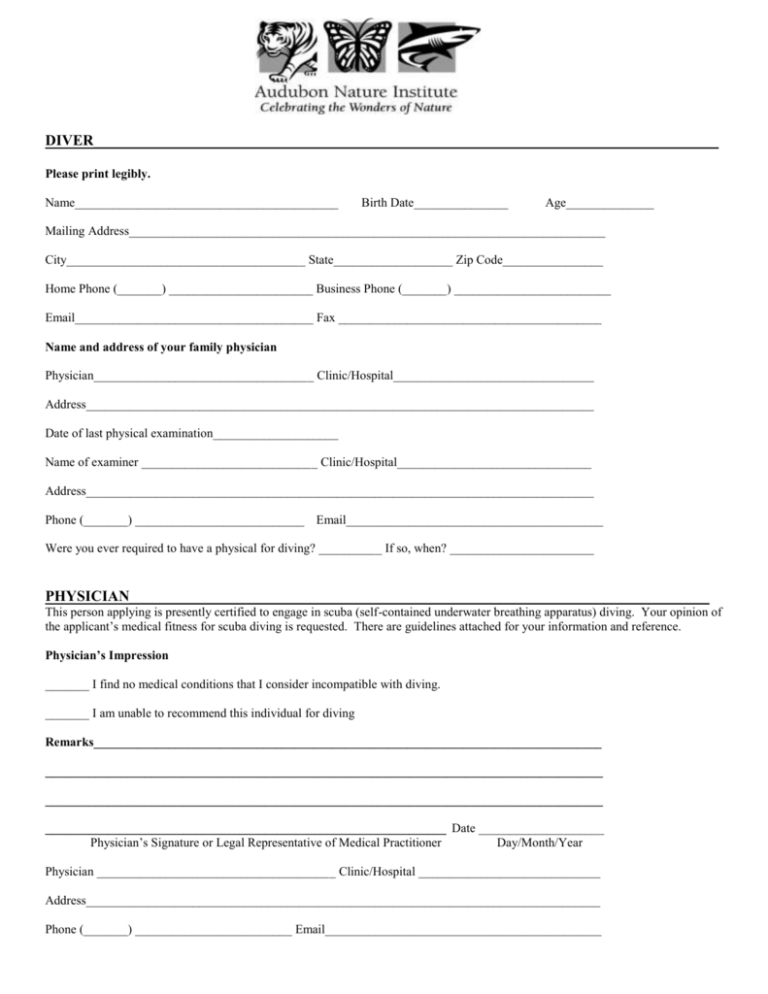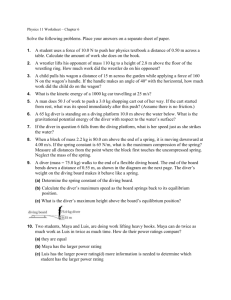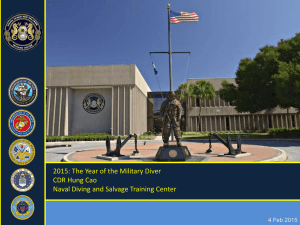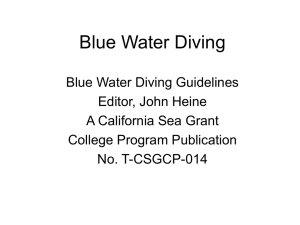Medical Evaluations - Audubon Nature Institute
advertisement

DIVER___________________________________________________________________________________ Please print legibly. Name__________________________________________ Birth Date_______________ Age______________ Mailing Address____________________________________________________________________________ City______________________________________ State___________________ Zip Code________________ Home Phone (_______) _______________________ Business Phone (_______) _________________________ Email______________________________________ Fax __________________________________________ Name and address of your family physician Physician___________________________________ Clinic/Hospital________________________________ Address_________________________________________________________________________________ Date of last physical examination____________________ Name of examiner ____________________________ Clinic/Hospital_______________________________ Address_________________________________________________________________________________ Phone (_______) ___________________________ Email_________________________________________ Were you ever required to have a physical for diving? __________ If so, when? _______________________ PHYSICIAN_____________________________________________________________________________ This person applying is presently certified to engage in scuba (self-contained underwater breathing apparatus) diving. Your opinion of the applicant’s medical fitness for scuba diving is requested. There are guidelines attached for your information and reference. Physician’s Impression _______ I find no medical conditions that I consider incompatible with diving. _______ I am unable to recommend this individual for diving Remarks_________________________________________________________________________________ _________________________________________________________________________________________ _________________________________________________________________________________________ ________________________________________________________________ Date ____________________ Physician’s Signature or Legal Representative of Medical Practitioner Day/Month/Year Physician ______________________________________ Clinic/Hospital _____________________________ Address__________________________________________________________________________________ Phone (_______) _________________________ Email____________________________________________ Guidelines for Recreational Scuba Diver’s Physical Examination Instructions to the Physician: Recreational SCUBA (Self-Contained Underwater Breathing Apparatus) can provide recreational divers with an enjoyable sport safer than many other activities. The risk of diving is increased by certain physical conditions, which the relationship to diving may not be readily obvious. Thus, it is important to screen divers for such conditions. The RECREATIONAL SCUBA DIVER’S PHYSICAL EXAMINATION focuses on conditions that may put a diver at increased risk for decompression sickness, pulmonary overinflation syndrome with subsequent arterial gas embolization and other conditions such as loss of consciousness, which could lead to drowning. Additionally, the diver must be able to withstand some degree of cold stress, the physiological effects of immersion and the optical effects of water and have sufficient physical and mental reserves to deal with possible emergencies. The history, review of systems and physical examination should include as a minimum the points listed below. The list of conditions that might adversely affect the diver is not all-inclusive, but contains the most commonly encountered medical problems. The brief introductions should serve as an alert to the nature of the risk posed by each medical problem. The potential diver and his or her physician must weigh the pleasures to be had by diving against an increased risk of death or injury due to the individual’s medical condition. As with any recreational activity, there are no data for diving enabling the calculation of an accurate mathematical probability of injury. Experience and physiological principles only permit a qualitative assessment of relative risk. For the purposes of this document, Severe Risk implies that an individual is believed to be at substantially elevated risk of decompression sickness, pulmonary or otic barotraumas or altered consciousness with subsequent drowning, compared with the general population. The consultants involved in drafting this document would generally discourage a person with such medical problems from diving. Relative Risk refers to moderate increase in risk, which in some instances may be acceptable. To make a decision as to whether diving is contraindicated for this category of medical problems; physicians must base their judgment on an assessment of individual patient. Some medical problems which may preclude diving are temporary in nature or responsive to treatment, allowing the person to dive safely after they have resolved. Diagnostic studies and specialty consultations should be obtained as indicated to determine the diver’s status. A list of references is included to aid in clarifying issues that arise. Physicians and other medical professionals of the Divers Alert Network (DAN) associated with Duke University Health System are available for consultation by phone +1 919 684 2948 during normal business hours. For emergency calls, 24 hours 7 days a week, call +1 919 684 8111 or +1 919 684 4DAN (collect). Related organizations exist in other parts of the world – DAN Europe in Italy +39 039 605 7858, DAN S.E.A.P. in Australia +61 3 9886 9166 and Divers Emergency Service (DES) in Australia +61 8 8212 9242, DAN Japan +81 33590 6501 and DAN Southern Africa +27 11 242 0380. There are also a number of informative websites offering similar advice. NEUROLOGICAL Neurological abnormalities affecting a diver’s ability to perform exercise should be assessed according to the degree of compromise. Some diving physicians feel that conditions in which there can be a waxing and waning of neurological symptoms and signs, such as migraine or demyelinating disease, contraindicate diving because an exacerbation or attack of the preexisting disease (e.g.: a migraine with aura) may be difficult to distinguish from neurological decompression sickness. A history of head injury resulting in unconsciousness should be evaluated for risk of seizure. Relative Risk Conditions Complicated Migraine Headaches whose symptoms or severity impair motor or cognitive function, neurologic manifestations. History of Head Injury with sequelae other than seizure Herniated Nucleus Pulposus Intracranial Tumor or Aneurysm Peripheral Neuropathy Multiple Sclerosis Trigeminal Neuralgia History of spinal cord or brain injury Temporary Risk Condition History of cerebral gas embolism without residual where pulmonary air trapping has been excluded and for which there is a satisfactory explanation and some reason to believe that the probability of recurrence is low. Severe Risk Conditions Any abnormalities where there is a significant probability of unconsciousness, hence putting the diver at increased risk of drowning. Divers with spinal cord or brain abnormalities where perfusion is impaired may be at increased risk of decompression sickness. Some conditions are as follows: History of seizures other than childhood febrile seizures History of Transient Ischemic Attack (TIA) or Cerebrovascular Accident (CVA) History of Serious (Central Nervous System, Cerebral, or Inner Ear) Decompression Sickness with residual deficits CARDIOVASCULAR SYSTEMS Relative Risk Conditions The diagnoses listed below potentially render the diver unable to meet the exertional performance requirements likely to be encountered in recreational diving. These conditions may lead the diver to experience cardiac ischemia and its consequences. Formalized stress testing is encouraged if there is any doubt regarding physical performance capability. The suggested minimum criteria for stress testing in such cases is at least 13 METS.* Failure to meet the exercise criteria would be of significant concern. Conditioning and retesting may make later qualification possible. Immersion in water causes a redistribution of blood from the periphery into the central compartment, an effect that is greatest in cold water. The marked increase in cardiac preload during immersion can precipitate pulmonary edema in patients with impaired left ventricular function or significant valvular disease. The effects of immersion can mostly be gauged by an assessment of the diver’s performance while swimming on the surface. A large proportion of scuba diving deaths in North America are due to coronary artery disease. Before being approved to scuba dive, individuals older than 40 years are recommended to undergo risk assessment for coronary artery disease. Formal exercise testing may be needed to assess the risk. Relative Risk Conditions History of Coronary Artery Bypass Grafting (CABG) Percutaneous Balloon Angioplasty (PCTA) or Coronary Artery Disease (CAD) History of Myocardial Infarction Congestive Heart Failure Hypertension History of dysrythmias requiring medication for suppression Valvular Regurgitation Pacemakers The pathologic process that necessitated should be addressed regarding the diver’s fitness to dive. In those instances where the problem necessitating pacing does not preclude diving, will the diver be able to meet the performance criteria? *NOTE: Pacemakers must be certified by the manufacturer as able to withstand the pressure changes involved in recreational diving. Severe Risks Venous emboli, commonly produced during decompression, may cross major intracardiac right-to-left shunts and enter the cerebral or spinal cord circulations causing neurological decompression illness. Hypertrophic cardiomyopathy and valvular stenosis may lead to the sudden onset of unconsciousness during exercise. *METS is a term used to describe the metabolic cost. The MET at rest is one, two METS is two times the resting level, three METS is three times the resting level, and so on. The resting energy cost (net oxygen requirement) is thus standardized. (Exercise Physiology; Clark, Prentice Hall, 1975.) PULMONARY Any process or lesion that impedes airflow from the lungs places the diver at risk for pulmonary overinflation with alveolar rupture and the possibility of cerebral air embolization. Many interstitial diseases predispose to spontaneous pneumothorax: Asthma (reactive airway disease), Chronic Obstructive Pulmonary Disease (COPD), cystic or cavitating lung diseases may all cause air trapping. The 1996 Undersea and Hyperbaric Medical Society (UHMS) consensus on diving and asthma indicates that for the risk of pulmonary barotraumas and decompression illness to be acceptably low, the asthmatic diver should be asymptomatic and have normal spirometry before and after an exercise test. Inhalation challenge tests (e.g.: using histamine, hypertonic saline, or methacholine) are not sufficiently standardized to be interpreted in the context of scuba diving. A pneumothorax that occurs or reoccurs while diving may be catastrophic. As the diver ascends, air trapped in the cavity expands and could produce a tension pneumothorax. In addition to the risk of pulmonary barotraumas, respiratory disease due to either structural disorders of the lung or chest wall or neuromuscular disease may impair exercise performance. Structural disorders of the chest or abdominal wall (e.g.: prune belly), or neuromuscular disorders, may impair cough, which could be life threatening if water is aspirated. Respiratory limitation due to disease is compounded by the combined effects of immersion (causing a restrictive deficit) and the increase in gas density, which increases in proportion to the ambient pressure (causing increased airway resistance). Formal exercise testing may be helpful. Relative Risk Conditions * History of Asthma or Reactive Airway Disease (RAD)* History of Exercise Induced Bronchospasm (EIB)* History of solid, cystic, or cavitating lesion* Pneumothorax secondary to: o Thoracic Surgery o Trauma or Pleural Penetration* o Previous Overinflation Injury* Obesity History of Immersion Pulmonary Edema Restrictive Disease* Interstitial lung disease: May increase the risk of pneumothorax Spirometry should be normal before and after exercise Active Reactive Airway Disease, Active Asthma, Exercise Induced Bronchospasm, Chronic Obstructive Pulmonary Disease or history of same with abnormal PFTs or a positive exercise challenge are concerns for diving. Severe Risk Conditions History of spontaneous pneumothorax. Individuals who have experienced spontaneous pneumothorax should avoid diving, even after a surgical procedure designed to prevent recurrence (such as pleurodesis). Surgical procedures either do not correct the underlying lung abnormality (e.g.: pleurodesis, apical pleurectomy) or may not totally correct it (e.g.: resection of blebs or bullae). Impaired exercise performance due to respiratory disease. GASTROINTESTINAL Temporary Risks As with other organ systems and disease states, a process which chronically debilitates the diver may impair exercise performance. Additionally, dive activities may take place in areas remote from medical care. The possibility of acute recurrences of disability or lethal symptoms must be considered. Temporary Risk Conditions Peptic Ulcer Disease associated with pyloric obstruction or severe reflux Unrepaired hernias of the abdominal wall large enough to contain bowel within the hernia sac could incarcerated. Relative Risk Conditions Inflammatory Bowel Disease Functional Bowel Disorders Severe Risks Altered anatomical relationships secondary to surgery or malformations that lead to gas trapping may cause serious problems. Gas trapped in a hollow viscous expands as the diver surfaces and can lead to rupture or, in the case of the upper GI tract, emesis. Emesis underwater may lead to drowning. Severe Risk Conditions Gastric outlet obstruction of a degree sufficient to produce recurrent vomiting Chronic or recurrent small bowel obstruction Severe gastroesophageal reflux Achalasia Paraesophageal Hernia ORTHOPAEDIC Relative impairment of mobility, particularly in a boat or ashore with equipment weighing up to 18 kgs/40 pounds must be assessed. Orthopaedic conditions of a degree sufficient to impair exercise performance may increase the risk. Relative Risk Conditions Amputation Scoliosis must also assess impact on respiratory function and exercise performance Aseptic Necrosis possible risk of progression due to effects of decompression (evaluate the underlying medical cause of decompression may accelerate/escalate the progression). Temporary Risk Conditions Back Pain HEMATOLOGICAL Abnormalities resulting in altered rheological properties may theoretically increase the risk of decompression sickness. Bleeding disorders could worsen the effects of otic or sinus barotraumas, and exacerbate the injury associated with inner ear or spinal cord decompression sickness. Spontaneous bleeding into the joints (e.g.: in hemophilia) may be difficult to distinguish from decompression illness. Relative Risk Conditions Sickle Cell Disease Polycythemia Vera Leukemia Hemophilia/Impaired Coagulation METABOLIC AND ENDOCRINOLOGICAL With the exception of diabetes mellitus, states of altered hormonal or metabolic function should be assessed according to their impact on the individual’s ability to tolerated the moderated exercise requirement and environmental stress of sport diving. Obesity may predispose the individual to decompression sickness, can impair exercise tolerance and is a risk factor for coronary artery disease. Relative Risk Conditions Hormonal Excess or Deficiency Obesity Renal Insufficiency Severe Risk Conditions The potentially rapid change in level of consciousness associated with hypoglycemia in diabetics on insulin therapy or certain oral hypoglycemic medications can result in drowning. Diving is therefore generally contraindicated, unless associated with a specialized program that addresses these issues. [See “Guidelines for Recreational Diving with Diabetes” at www/wrstc.com and www.diversalertnetwork.org.] Pregnancy: The effect of venous emboli formed during decompression on the fetus has not been thoroughly investigated. recommended during any stage of pregnancy or for women actively seeking to become pregnant. Diving is therefore not BEHAVIORAL HEALTH Behavioral: The diver’s mental capacity and emotional make-up are important to safe diving. The diver must have sufficient abilities to grasp information presented by leaders or guides, be able to safely plan and execute his/her own dives and react to changes around him/her in the underwater environment. The diver’s motivation to learn and his/her ability to deal with potentially dangerous situations are also crucial to safe scuba diving. Relative Risk Conditions Developmental Delay History of drug or alcohol abuse History of previous psychotic episodes Use of psychotropic medications Severe Risk Conditions Inappropriate motivation to dive – solely to please spouse, partner, or family member, to prove oneself in the face of personal fears Claustrophobia and agoraphobia Active psychosis History of untreated panic disorder Drug or alcohol abuse OTOLARYNGOLOGICAL Equalization of pressure must take place during ascent and descent between ambient water pressure and the external auditory canal, middle ear, and paranasal sinuses. Failure of this to occur results at least in pain and in the worst case rupture of the occluded space with disabling and possible lethal consequences. The inner ear is fluid filled and therefore noncompressible. The flexible interfaces between the middle and inner ear, the round and oval windows are, however subject to pressure changes. Previously ruptured but healed round or oval window membranes are at increased risk of rupture due to failure to equalize pressure due to marked overpressurization during vigorous or explosive Valsalva manoeuvres. The larynx and pharynx must be free of an obstruction to airflow. The Laryngeal and epiglotic structure must function normally to prevent aspiration. Mandibular and maxillary function must be capable of allowing the patient to hold a scuba mouthpiece. Individuals who have had mid-face fractures may be prone to barotraumas and rupture of the air filled cavities involved. Relative Risk Conditions Recurrent otitis externa Significant obstruction of external auditory canal History of significant cold injury to pinna Eustachian tube dysfunction Recurrent otitis media or sinusitis History of mastoidectomy Significant conductive or sensorineural hearing impairment Facial nerve paralysis not associated with barotraumas Full prosthedontic devices History of mid-face fractures Unhealed oral surgery sites History of head and/or neck therapeutic radiation History of temperomandibular joint dysfunction History of round window rupture Severe Risk Conditions Monomeric TM Open TM perforation Tube myringotomy History of stapedectomy History of ossicular chain surgery History of inner ear surgery Facial nerve paralysis secondary to barotrauma Inner ear disease other than presbycusis Uncorrected upper airway obstruction Laryngectomy or status post partial laryngectomy Tracheostomy Uncorrected laryngocele History of vestibular decompression sickness BIBLIOGRAPHY/REFERENCE 1. Bennett, P. & Elliot, D (eds.) (1993). The Physiology and Medicine of Diving. 4th Ed., W.B. Saunders Company Ltd., London, England. 2. Bove, A., & Davis, J. (1990). Diving Medicine. 2nd Edition, W.B. Saunders Company, Philadelphia, PA. 3. Davis, J., & Bove, A. (1986). “Medical Examination of Sport Scuba Divers, Medical Seminars, Inc.” San Antonio, TX. 4. Dembert, M. & Keith, J. (1986). “Evaluating the Potential Pediatric Scuba Diver.” AJDC, Vol. 140, November. 5. Edmonds, C., Lowry, C., & Pennefether, J. (1992). 3rd ed., Diving and Subaquatic Medicine. Butterworth & Heineman Ltd., Oxford, England. 6. Elliott, D. (Ed) (1994). “Medical Assessment of Fitness to Dive.” Proceeding of an International Conference at the Edinburgh Conference Centre, Biomedical Seminars, Surry, England. 7. “Fitness to Dive,” Proceedings of the 34th Underwater & Hyperbaric Medical Society Workshop (1987) UHMS Publication Number 70 (WS-FD) Bethesda, MD. 8. Neuman, T. & Bove, A. (1994). “Asthma and Diving.” Ann. Allergy, Vol. 73, October, O’Conner & Kelsen. 9. Shilling, C.& Carlston, D. & Mathias, R. (eds) (1984). The Physicians’s Guide to Diving Medicine. Plennum Press, New York, NY. 10. Undersea and Hyperbaric Medical Society (UHMS) www.UHMS.org. 11. Divers Alert Network (DAN) United States, 6 West Colony Place, Durham, NC www.DiversAlertNetwork.org 12. Divers Alert Network Europe, P.P. Box 64026 Roseto, Italy, telephone non-emergency line: weekdays office hours +39-085-893-0333, emergency line 24 hours: +39-039-605-7858. 13. Divers Alert Network S.E.A.P., P.O. Box 384, Ashburton, Australia, telephone 61-3-9886-9166 14. Divers Emergency Service, Australia, www.rah.sa.gov.au/hyperbaric, telephone 61-8-8212-9242 15. South Pacific Underwater Medicine Society (SPUMS), P.O. Box 190, Red Hill South, Victoria, Australia, www.spums.org.au 16. European Underwater and Baromedical Society, www.eubs.org







